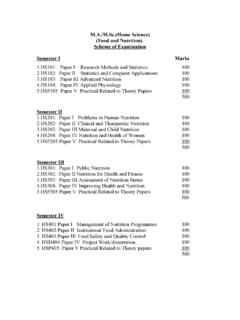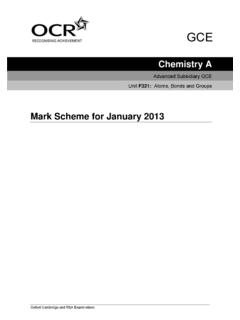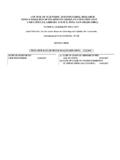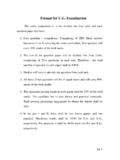Transcription of Mark Scheme for June 2012 - OCR
1 GCE Oxford Cambridge and RSA Examinations Advanced GCE Unit 4723: Core Mathematics 3 Mathematics Mark Scheme for june 2012 OCR (Oxford Cambridge and RSA) is a leading UK awarding body, providing a wide range of qualifications to meet the needs of candidates of all ages and abilities. OCR qualifications include AS/A Levels, Diplomas, GCSEs, OCR Nationals, Functional Skills, Key Skills, Entry Level qualifications, NVQs and vocational qualifications in areas such as IT, business, languages, teaching/training, administration and secretarial skills. It is also responsible for developing new specifications to meet national requirements and the needs of students and teachers. OCR is a not-for-profit organisation; any surplus made is invested back into the establishment to help towards the development of qualifications and support, which keep pace with the changing needs of today s society.
2 This mark Scheme is published as an aid to teachers and students, to indicate the requirements of the examination. It shows the basis on which marks were awarded by examiners. It does not indicate the details of the discussions which took place at an examiners meeting before marking commenced. All examiners are instructed that alternative correct answers and unexpected approaches in candidates scripts must be given marks that fairly reflect the relevant knowledge and skills demonstrated. Mark schemes should be read in conjunction with the published question papers and the report on the examination. OCR will not enter into any discussion or correspondence in connection with this mark Scheme . OCR 2012 Any enquiries about publications should be addressed to: OCR Publications PO Box 5050 Annesley NOTTINGHAM NG15 0DL Telephone: 0870 770 6622 Facsimile: 01223 552610 E-mail.
3 4723 Mark Scheme june 2012 Annotations and abbreviations Annotation in scoris Meaning and BOD Benefit of doubt FT Follow through ISW Ignore subsequent working M0, M1 Method mark awarded 0, 1 A0, A1 Accuracy mark awarded 0, 1 B0, B1 Independent mark awarded 0, 1 SC Special case ^ Omission sign MR Misread Highlighting Other abbreviations in mark Scheme Meaning E1 Mark for explaining U1 Mark for correct units G1 Mark for a correct feature on a graph M1 dep* or dep*M Method mark dependent on a previous mark.
4 Indicated by * cao Correct answer only oe Or equivalent rot Rounded or truncated soi Seen or implied www Without wrong working A2 Accuracy mark awarded 2 1 4723 Mark Scheme june 2012 Subject-specific Marking Instructions for GCE Mathematics Pure strand a. Annotations should be used whenever appropriate during your marking. The A, M and B annotations must be used on your standardisation scripts for responses that are not awarded either 0 or full marks . It is vital that you annotate standardisation scripts fully to show how the marks have been awarded. For subsequent marking you must make it clear how you have arrived at the mark you have awarded. b. An element of professional judgement is required in the marking of any written paper.
5 Remember that the mark Scheme is designed to assist in marking incorrect solutions. Correct solutions leading to correct answers are awarded full marks but work must not be judged on the answer alone, and answers that are given in the question, especially, must be validly obtained; key steps in the working must always be looked at and anything unfamiliar must be investigated thoroughly. Correct but unfamiliar or unexpected methods are often signalled by a correct result following an apparently incorrect method. Such work must be carefully assessed. When a candidate adopts a method which does not correspond to the mark Scheme , award marks according to the spirit of the basic Scheme ; if you are in any doubt whatsoever (especially if several marks or candidates are involved) you should contact your Team Leader.
6 C. The following types of marks are available. M A suitable method has been selected and applied in a manner which shows that the method is essentially understood. Method marks are not usually lost for numerical errors, algebraic slips or errors in units. However, it is not usually sufficient for a candidate just to indicate an intention of using some method or just to quote a formula; the formula or idea must be applied to the specific problem in hand, eg by substituting the relevant quantities into the formula. In some cases the nature of the errors allowed for the award of an M mark may be specified. A Accuracy mark, awarded for a correct answer or intermediate step correctly obtained. Accuracy marks cannot be given unless the associated Method mark is earned (or implied). Therefore M0 A1 cannot ever be awarded.
7 B Mark for a correct result or statement independent of Method marks . 2 4723 Mark Scheme june 2012 E A given result is to be established or a result has to be explained. This usually requires more working or explanation than the establishment of an unknown result. Unless otherwise indicated, marks once gained cannot subsequently be lost, eg wrong working following a correct form of answer is ignored. Sometimes this is reinforced in the mark Scheme by the abbreviation isw. However, this would not apply to a case where a candidate passes through the correct answer as part of a wrong argument. d. When a part of a question has two or more method steps, the M marks are in principle independent unless the Scheme specifically says otherwise; and similarly where there are several B marks allocated.
8 (The notation dep * is used to indicate that a particular mark is dependent on an earlier, asterisked, mark in the Scheme .) Of course, in practice it may happen that when a candidate has once gone wrong in a part of a question, the work from there on is worthless so that no more marks can sensibly be given. On the other hand, when two or more steps are successfully run together by the candidate, the earlier marks are implied and full credit must be given. e. The abbreviation ft implies that the A or B mark indicated is allowed for work correctly following on from previously incorrect results. Otherwise, A and B marks are given for correct work only differences in notation are of course permitted. A (accuracy) marks are not given for answers obtained from incorrect working. When A or B marks are awarded for work at an intermediate stage of a solution, there may be various alternatives that are equally acceptable.
9 In such cases, exactly what is acceptable will be detailed in the mark Scheme rationale. If this is not the case please consult your Team Leader. Sometimes the answer to one part of a question is used in a later part of the same question. In this case, A marks will often be follow through . In such cases you must ensure that you refer back to the answer of the previous part question even if this is not shown within the image zone. You may find it easier to mark follow through questions candidate-by-candidate rather than question-by-question. f. Wrong or missing units in an answer should not lead to the loss of a mark unless the Scheme specifically indicates otherwise. Candidates are expected to give numerical answers to an appropriate degree of accuracy, with 3 significant figures often being the norm.
10 Small variations in the degree of accuracy to which an answer is given ( 2 or 4 significant figures where 3 is expected) should not normally be penalised, while answers which are grossly over- or under-specified should normally result in the loss of a mark. The situation regarding any particular cases where the accuracy of the answer may be a marking issue should be detailed in the mark Scheme rationale. If in doubt, contact your Team Leader. g. Rules for replaced work If a candidate attempts a question more than once, and indicates which attempt he/she wishes to be marked, then examiners should do as the candidate requests. If there are two or more attempts at a question which have not been crossed out, examiners should mark what appears to be the last (complete) attempt and ignore the others.

















